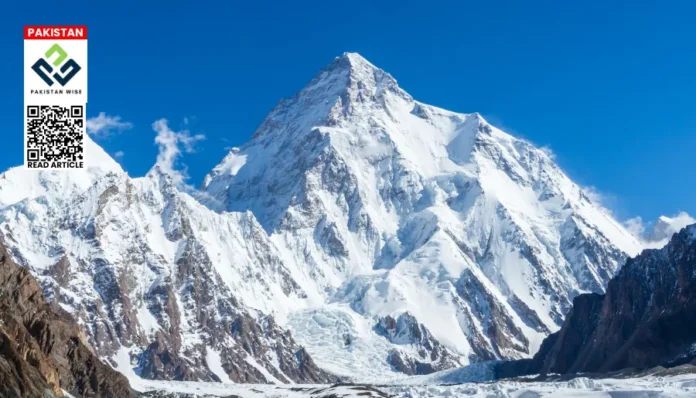- Pakistan offers world-class mountaineering with K2, Nanga Parbat, and Broad Peak attracting global climbers.
- Government permits, ACP training, and eco-conscious regulations ensure safety and sustainability in mountain expeditions.
- Mountaineering boosts tourism, supports local jobs, and promotes Pakistan’s rich natural and cultural heritage.
Climbing Pakistan’s Majestic Peaks: K2, Nanga Parbat & More
Mountaineering in Pakistan offers a thrilling and unparalleled adventure for climbers and nature enthusiasts worldwide, thanks to its majestic and challenging mountain ranges. The country is home to some of the highest and most formidable peaks on the planet, making it a premier destination for mountaineering.
Majestic Mountain Ranges and Peaks
Pakistan’s mountainous landscape is dominated by three major ranges: the Karakoram, the Himalayas, and the Hindu Kush. The Karakoram Range, in particular, is renowned for its vast glaciers and towering summits, including K2, the world’s second-highest mountain at 8,611 meters (28,251 feet).
Other notable peaks include Nanga Parbat, famously known as the “Killer Mountain” for its steep faces and avalanche risks, and Broad Peak, recognized for its pyramid-shaped summit and technical climbing challenges. These mountains offer unique and diverse climbing experiences, from treacherous ice walls to unpredictable weather conditions, attracting mountaineers seeking both adventure and natural beauty.
Historical and Institutional Support
Mountaineering has a rich history in Pakistan, with the Alpine Club of Pakistan (ACP) established in 1974 to promote and support mountain-related activities. The ACP has organized numerous expeditions to high peaks both within Pakistan and internationally, including K2, Nanga Parbat, Broad Peak, and even Mount Everest.
The club provides training, facilitates expeditions, and collaborates with international mountaineering organizations, playing a crucial role in preserving Pakistan’s mountain heritage and promoting safe mountaineering practices.
Regulations and Permits
Mountaineering in Pakistan, especially in Gilgit-Baltistan, requires adherence to specific rules and regulations. For peaks above 6,500 meters, permits must be obtained from the Gilgit-Baltistan Council Secretariat through registered tour operators.
These permits ensure regulated and responsible climbing activities, contributing to the preservation of the mountain environment. Notably, trekking in open areas below this altitude generally does not require permits, making it accessible for a wide range of adventurers.
Economic and Tourism Impact
Mountaineering is increasingly recognized as a strategic avenue to boost tourism and economic growth in Pakistan. The Pakistan Tourism Development Corporation (PTDC) highlights that the country’s mountains not only offer breathtaking natural beauty but also significant cultural and ecological value. Promoting mountaineering can create jobs, stimulate local businesses, and encourage eco-conservation efforts.
The PTDC actively participates in international adventure tourism events to showcase Pakistan’s potential and aims to develop infrastructure such as trekking routes, base camps, and mountain lodges to enhance the experience for both domestic and international tourists.
Popular Mountaineering Routes
- K2 Base Camp Trek: A demanding trek that rewards adventurers with breathtaking panoramic views of the majestic Karakoram Range and the formidable base of the legendary ‘Savage Mountain.’
- Fairy Meadows to Nanga Parbat Base Camp: A scenic route through lush meadows leading to the base of one of the most daunting peaks in the world.
- Spantik Peak: Known as one of the most accessible 7,000-meter peaks, it is popular among intermediate climbers seeking high-altitude experience.
Pakistan’s mountains some of the most challenging for climbers
Pakistan’s mountains are among the most challenging for climbers due to a combination of extreme altitude, technical difficulty, unpredictable and harsh weather, and dangerous terrain.
Key Factors Making Pakistan’s Mountains Exceptionally Challenging
Extreme Altitude and Physical Demands
Many of Pakistan’s peaks, including K2 (8,611 m) and Nanga Parbat (8,126 m), are among the highest in the world. The altitude itself poses severe risks such as oxygen deprivation and altitude sickness, requiring climbers to have exceptional physical conditioning and acclimatization skills.
Technical Climbing Difficulty
Pakistan’s mountains demand advanced technical skills in rock, ice, and mixed climbing. For example, K2 involves steep, exposed ridgelines and rock faces with grades up to 80 degrees, requiring expert proficiency in multiple climbing techniques. Nanga Parbat’s Rupal Face is the largest mountain face on Earth, with slopes varying from 40 to 90 degrees, making it one of the most technically demanding climbs globally.
Unpredictable and Severe Weather Conditions
The weather on these peaks is highly volatile and often extreme. K2 is notorious for cyclonic winds, temperatures dropping to -65°C, and frequent snowstorms, especially in winter, making it the last 8,000-meter peak to be summited in winter as of 2021. Nanga Parbat faces gale-force winds and sudden weather changes, adding to the danger.
High Risk of Avalanches and Rockfalls
Avalanches and falling rocks are constant threats on these mountains. The steep slopes and unstable snow and ice conditions increase the likelihood of deadly avalanches, which have claimed many lives on peaks like K2 and Nanga Parbat.
Remote and Difficult Access
Many of these mountains are located in remote regions with limited rescue options. This remoteness complicates emergency responses and adds to the psychological and logistical challenges climbers face.
Historical Fatality Rates and Reputation
Nanga Parbat is known as the “Killer Mountain” due to its high death toll, with a mortality rate historically as high as 77% before 1990 and still around 20-22% today. K2 has a similarly high fatality rate of approximately 23-25%, making it deadlier than Mount Everest despite being slightly lower in elevation. These statistics reflect the extreme danger and difficulty involved.
Conclusion
Mountaineering in Pakistan is not just an adventurous sport but a gateway to exploring some of the most dramatic and beautiful landscapes on Earth. With its towering peaks, rich mountaineering history, supportive institutions, and growing tourism infrastructure, Pakistan stands as a premier destination for climbers worldwide. Whether scaling the heights of K2 or trekking through the serene Fairy Meadows, mountaineering in Pakistan promises an unforgettable experience filled with challenge, beauty, and cultural richness.

